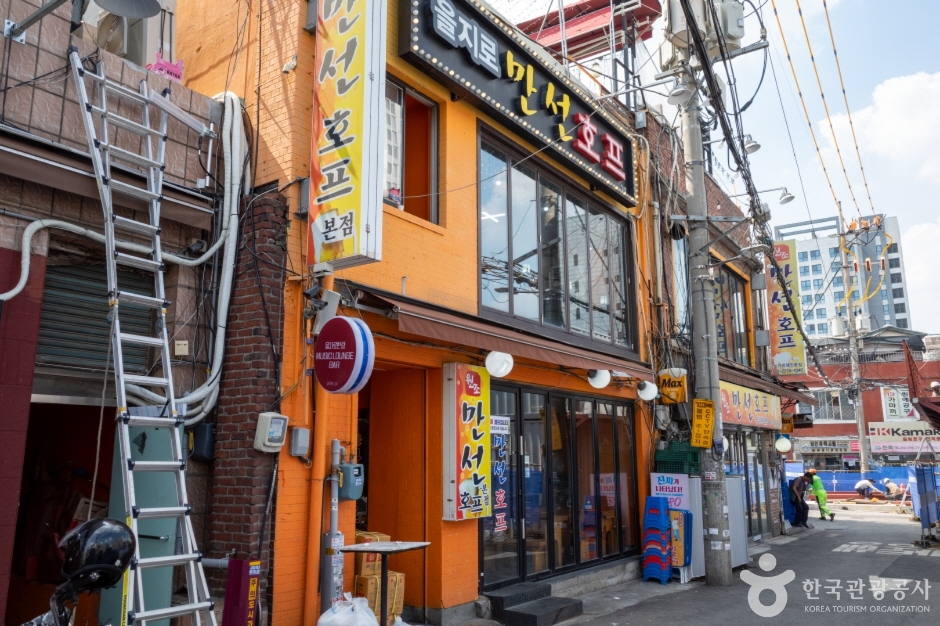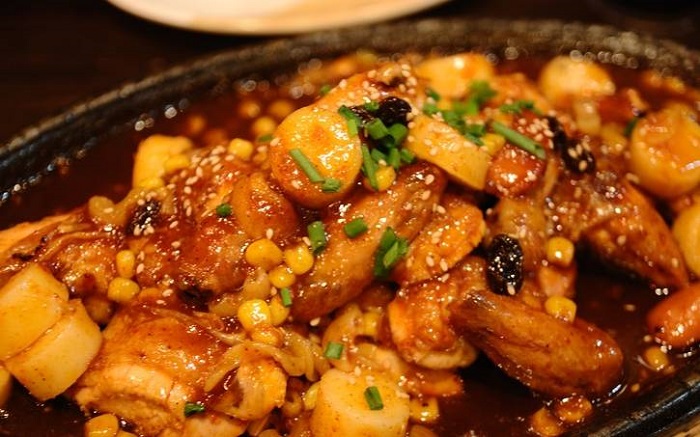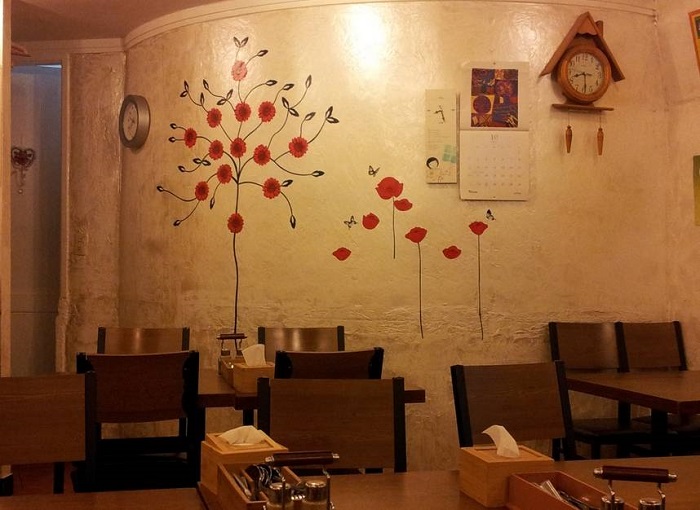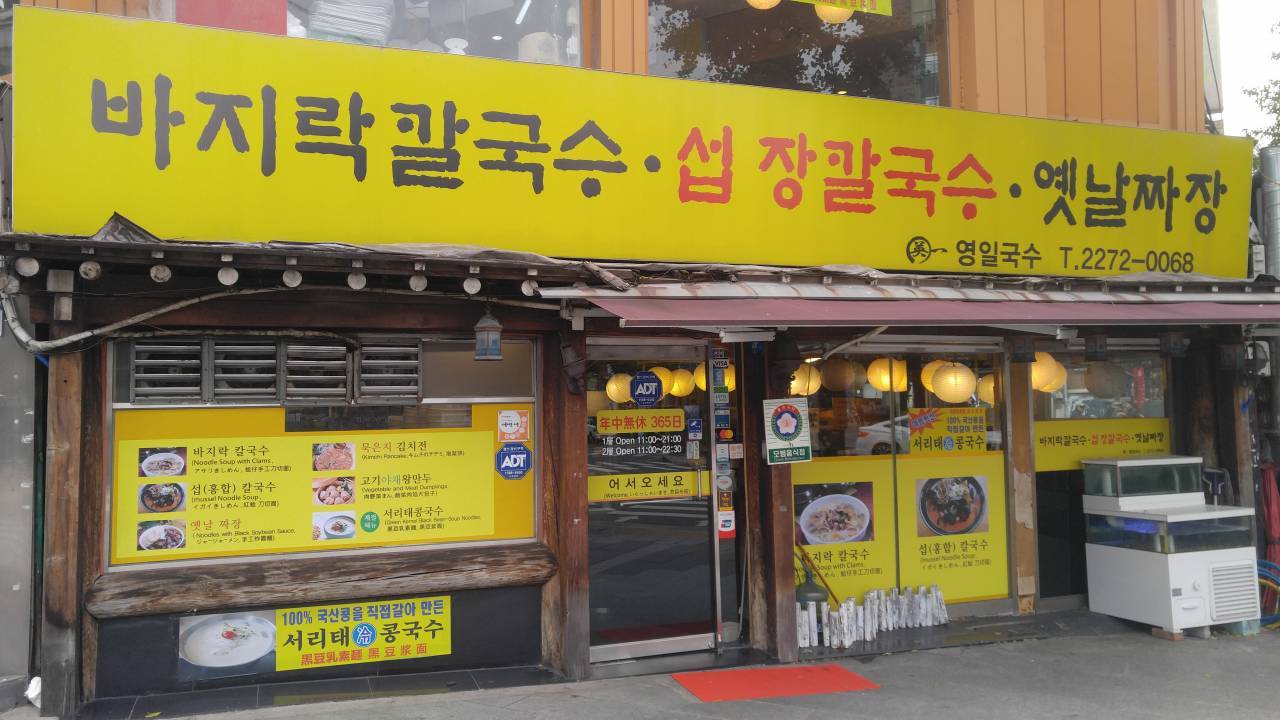Euljiro Nogari Alley (을지로 노가리골목)
2.3Km 2024-10-29
129, Eulji-ro, Jung-gu, Seoul
+82-2-1330
The alley that connects from Euljiro 3(sam)-ga Station, Exit 4 is full of people eating dried young pollack and drinking beers at tables along the street every night. Under the bright lamp lights, plastic tables filled with customers can be seen. The first Nogari pub, Eulji OB Bear, opened in November 1980 to form what is now the Euljiro Nogari Alley. Euljiro also has the largest Printing Alley in the nation, providing printing for almost all books and printed materials across the country. The shift workers would stop by the pub for dried young pollack and cold beer before heading home after work, leading to more restaurants opening nearby until the alley was formed. In the beginning dried young pollack was cooked over a briquet fire and served with red pepper paste, but now, the alley is full of pubs and restaurants serving various types of food, but nothing beats nogari and cold draft beer.
Look Optical - Hanyang Univ. Branch [Tax Refund Shop] (룩옵티컬 한양대)
2.3Km 2024-04-17
1F, 17, Majo-ro, Seongdong-gu, Seoul
-
Beer Ok (비어오크)
2.3Km 2021-03-29
151, Daehak-ro, Jongno-gu, Seoul
+82-2-745-0087
It's near the university, so it's a place frequented by many young people. This Korean dishes restaurant is located in Jongno-gu, Seoul. The representative menu is rotisserie chicken.
Eye On Optical - Hanyang Univ. Branch [Tax Refund Shop] (아이온안경 한양대)
2.3Km 2024-04-17
#101, 30, Majo-ro, Seongdong-gu, Seoul
-
Olive Young - Hanyang Univ. Branch [Tax Refund Shop] (올리브영 한양대)
2.3Km 2024-04-17
11, Majo-ro, Seongdong-gu, Seoul
-
Haengun Donkkaseu (행운돈까스)
2.3Km 2021-03-30
2, Majo-ro 1-gil, Seongdong-gu, Seoul
+82-2-2296-3406
It's near the university, so it's a place frequented by many young people. The best menu at this restaurant is pork cutlet with cheese. This Korean dishes restaurant is located in Seongdong-gu, Seoul.
Golmok Naengmyeon (골목냉면)
2.3Km 2021-03-26
295-7, Dokseodang-ro, Seongdong-gu, Seoul
+82-2-2235-2540
This is a Seoul-style naengmyeon (Korean cold noodle) restaurant that opened in 1966. This restaurant's signature menu is cold buckwheat noodles. This Korean dishes restaurant is located in Seongdong-gu, Seoul.
Traditional Performance at The Korea House (한국의집 전통예술공연 KOREA 심청)
2.3Km 2024-08-16
10, Toegye-ro 36-gil, Jung-gu, Seoul
• 1330 Travel Hotline: +82-2-1330 (Korean, English, Japanese, Chinese) • For more info: +82-2-2266-9101~3
The Korea House has been a venue for traditional performing arts for more than 20 years, presenting various musical performances, court dances, and folk dances such as Pungmulnori (farmers’ percussion
performance), Talchum (mask dance), Pansori (a traditional narrative vocal performance), and Sinawi (an ensemble of eight traditional musical instruments).
At Korea House, visitors can discover the diverseness and richness of Korean music and art performance. Popular and nationally recognized intangible cultural asset holders such as An Sook Seon, Park Byeong Cheon, and Lee Chun Hui perform on the stage under director Jeong Jae Man.
Chungmuro Ttukbaegi (충무로뚝배기)
2.3Km 2021-03-18
43, Mareunnae-ro, Jung-gu, Seoul
+82-2-2272-0068
Well-known for Korean spicy stew. The representative menu is kimchi stew. This Korean cuisine is located near Euljiro 3(sam)ga Station, Seoul.
Korea House (한국의집)
2.3Km 2024-10-28
10, Toegye-ro 36-gil, Jung-gu, Seoul
The Korea House was opened in 1981. It is a traditional Korean building that introduces the culture and lifestyle of Koreans, where you can experience traditional architecture and a classical atmosphere. The building was built in the style of the Joseon Dynasty's Jagyeong-jeon building at the Gyeongbok Palace. It is the only building built in the traditional architectural style. You will feel its antiquity as you enter the building.
It is divided into the Haerin-gwan (a space for people to get acquainted with each other), the Traditional Theater, and three annex buildings (Munhyang-ru, Nokeum-jeong and Cheongwu-jeong). At Haerin-gwan, you can enjoy traditional music at Garak-dang and try traditional food at Sohwa-dang. In the square of Garak-dang you can view a traditional wedding (on the weekends) or people playing folk games. Also, at the Traditional Theater, about 156 seats are available, and in the afternoons Human Cultural Assets or members of the National Center for Korean Traditional Performing Arts and the National Corps members present traditional music and dances. Sinayui, Salpuri, Pansori, the Drum Dance and the Bongsan Mask Dance are the most popular programs for foreigners. The programs are all explained in English and Japanese.
In the Cultural Gift Shop you can view various crafts made by traditional craftsmen. It is always open and the crafts are for sale as well. There are pottery, ceramics, golden crafts, knots and embroidery etc; approximately 500 pieces of artwork made by craftsmen from 20 different fields. Next to the House of Korea is the Namsan-gol Hanok Village where visitors can explore traditional houses.

![Look Optical - Hanyang Univ. Branch [Tax Refund Shop] (룩옵티컬 한양대)](http://tong.visitkorea.or.kr/cms/resource/74/2878774_image2_1.jpg)

![Eye On Optical - Hanyang Univ. Branch [Tax Refund Shop] (아이온안경 한양대)](http://tong.visitkorea.or.kr/cms/resource/77/2878777_image2_1.jpg)
![Olive Young - Hanyang Univ. Branch [Tax Refund Shop] (올리브영 한양대)](http://tong.visitkorea.or.kr/cms/resource/72/2878772_image2_1.jpg)




 English
English
 한국어
한국어 日本語
日本語 中文(简体)
中文(简体) Deutsch
Deutsch Français
Français Español
Español Русский
Русский